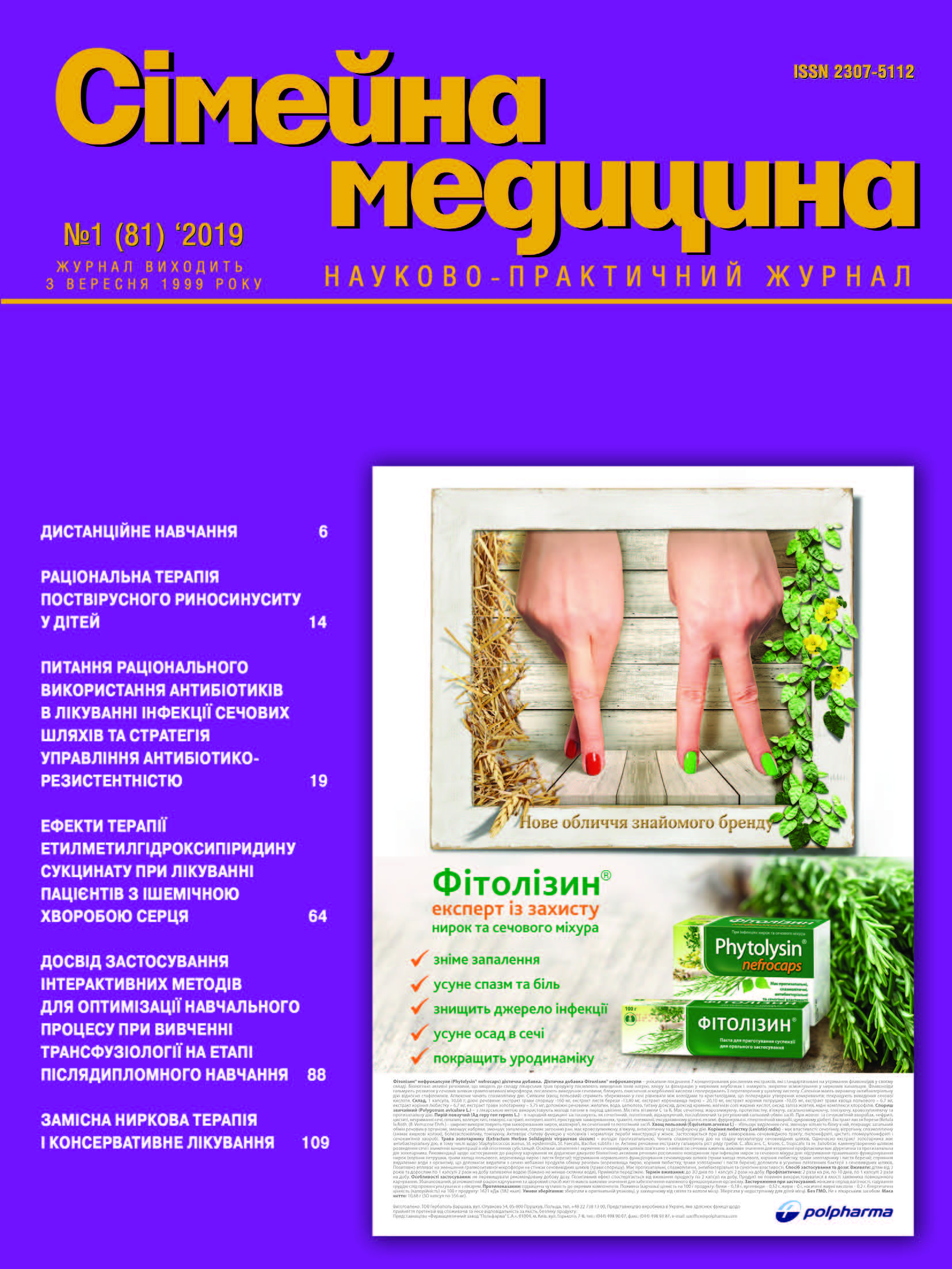Профілактика серцево-судинних захворювань при цукровому діабеті: роль глікемічного контролю
##plugins.themes.bootstrap3.article.main##
Анотація
##plugins.themes.bootstrap3.article.details##

Ця робота ліцензується відповідно до Creative Commons Attribution 4.0 International License.
Автори зберігають авторське право, а також надають журналу право першого опублікування оригінальних наукових статей на умовах ліцензії Creative Commons Attribution 4.0 International License, що дозволяє іншим розповсюджувати роботу з визнанням авторства твору та першої публікації в цьому журналі.
Посилання
Kengne AP, Patel A, Marre M et al. Contemporary model for cardiovascular risk prediction in people with type 2 diabetes. Eur J of Cardiovasc Prevent Rehab 2011; 18: 393–8. https://doi.org/10.1177/1741826710394270
Ogurtsova K, da Rocha Fernandes JD, Huang Y et al. IDF Diabetes Atlas: Global estimates for the prevalence of diabetes for 2015 and 2040. Diabetes Res Clin Pract 2017; 128: 40–50. https://doi.org/10.1016/j.diabres.2017.03.024
Yudkin JS, Richter B, Gale EAM. Intensified glucose lowering in type 2 diabetes: time for a reappraisal. Diabetologia 2010; 53 (10): 2079–85. https://doi.org/10.1007/s00125-010-1864-z
Khaled AA, Sekaran M, Ikram SI. Type 2 diabetes and vascular complications: A pathophysiologic view. Biomed Res 2010; 21 (2): 147–50. Full text
Bartnik M, Ryden L, Ferrari R et al. The prevalence of abnormal glucose regulation in patients with coronary artery disease across Europe. The Euro Heart Survey on diabetes and the heart. Eur Heart J 2004; 25 (21): 1880–90. https://doi.org/10.1016/j.ehj.2004.07.027
Duckworth WC, McCarren M, Abraira С. Glucose Control and Cardiovascular Complications: The VA Diabetes Tria. Diabetes Care 2001; 24 (5): 942–5. https://doi.org/10.2337/diacare.24.5.942
Bouche JL, Hurrell DJ. Cardiovascular Disease and Diabetes. Diabet spectrum 2008; 21(3): 154–5. https://doi.org/10.2337/diaspect.21.3.154
Bai J, Ding X, Du X et al. Diabetes is associated with increased risk of venous thromboembolism: a systematic review and meta-analysis. Thrombosis Research 2015; 135(1): 90–5. https://doi.org/10.1016/j.thromres.2014.11.003
Dentali F, Ageno W, Pomero F. Time trends and case fatality rate of in-hospital treated pulmonary embolism during 11 years of observation in Northwestern Italy. Thromb Haemost 2016; 115 (2): 399–405. https://doi.org/10.1160/TH15-02-0172
Powers WJ, Derdeyn CP, Biller J et al. 2015 AHA/ASA Focused Update of the 2013 Guidelines for the Early Management of Patients With Acute Ischemic Stroke Regarding Endovascular Treatment: A Guideline for Healthcare Professionals From the AHA/ASA. Stroke 2015; 46 (10): 3020–35. https://doi.org/10.1161/STR.0000000000000074
Meschia JF, Bushnell C, Boden-Albala B et al. Guidelines for the primary prevention of stroke: a statement for healthcare professionals from the AHA/ASA. Stroke 2014; 45 (12): 3754–832. https://doi.org/10.1161/STR.0000000000000046
Johnston KC, Hall CE, Kissela et al. Glucose regulation in acute stroke patients (GRASP) trial a randomized pilot trial. Stroke 2009; 40 (12): 3804–09. https://doi.org/10.1161/STROKEAHA.109.561498
Capes SE, Hunt D, Malmberg K et al. Stress hyperglycaemia and increased risk of death after myocardial infarction in patients with and without diabetes: a systematic overview. Lancet 2000; 355 (4): 773–8. https://doi.org/10.1016/S0140-6736(99)08415-9
Capes SE, Hunt D, Malmberg K et al. Stress hyperglycemia and prognosis of stroke in nondiabetic and diabetic patients: a systematic overview. Stroke 2001; 32: 10: 2426–32. https://doi.org/10.1161/hs1001.096194
Holman RR, Paul SK, Bethel MA et al. 10-year follow-up of intensive glucose control in type 2 diabetes. N Engl J Med 2008, 359 (15): 1577–89. https://doi.org/10.1056/NEJMoa0806470
The CREATE-ECLA Trial Group Investigators. Effect of glucose-insulinpotassium infusion on mortality in patients with acute ST-segment elevation myocardial infarction the CREATE-ECLA Randomized Controlled Trial. JAMA 2005; 293 (4): 437–46. https://doi.org/10.1001/jama.293.4.437
NICE-SUGAR study investigators. Intensive versus conventional glucose control in critically ill patients. N Engl J Med 2009; 360 (13): 1283–97. http://doi.org/10.1056/NEJMoa0810625
Bruno A, Kent TA, Coull BM et al. Treatment of hyperglycemia in ischemic stroke (THIS): a randomized pilot trial. Stroke 2008; 39 (2): 384–9. https://doi.org/10.1161/STROKEAHA.107.493544
Wiener RS, Wiener DC, Larson RJ. Benefits and risks of tight glucose control in critically ill adults: a meta-analysis. JAMA 2008; 300: 933–44. https://doi.org/10.1001/jama.300.8.933
Gerstein HC, Miller ME, Byington RP et al. Action to Control Cardiovascular Risk in Diabetes Study Group. Effects of intensive glucose lowering in type 2 diabetes. N Engl J Med 2008; 358 (24): 2545–59. https://doi.org/10.1056/NEJMoa0802743
Patel A, MacMahon S, Chalmers J et al. ADVANCE Collaborative Group. Intensive blood glucose control and vascular outcomes in patients with type 2 diabetes. N Engl J Med 2008; 358 (24): 2560–72. https://doi.org/10.1056/NEJMoa0802987
Duckworth W, Abraira C, Moritz T et al. VADT Investigators. Glucose control and vascular complications in veterans with type 2 diabetes. N Engl J Med 2009; 360 (2): 129–39. https://doi.org/10.1056/NEJMoa0808431
Tian F, Chen Y, Liu H et al. Assessment of characteristics of neointimal hyperplasia after drug-eluting stent implantation in patients with diabetes mellitus: an optical coherence tomography analysis. Cardiology 2014; 128 (1): 34–40. https://doi.org/10.1159/000357612





